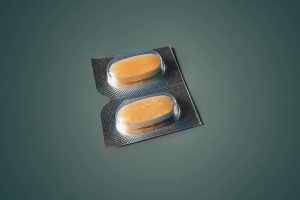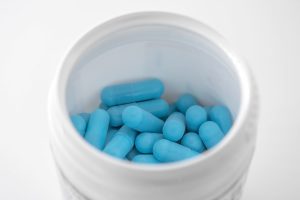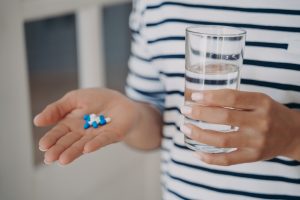Sexually transmitted diseases are often hidden, asymptomatic, and potentially dangerous. The problem is that many different bacteria and viruses can cause an STD. The treatment for each condition depends on knowing the specific body area where the organism can infect and providing a medication that can be of high concentration in that area to get a successful treatment. The medication under the spotlight today is nitrofurantoin. This medication is commonly used to treat urinary tract infections, but how does it protect against STDs? This article will discuss everything you need to know about nitrofurantoin for STD.
What Is Nitrofurantoin?
Nitrofurantoin belongs to what we call broad-spectrum antibiotics. These antibiotics can eliminate more than one type of bacteria using the same dose. However, they need to have high concentrations in the infected parts.
Nitrofurantoin specializes in dealing with infections of the lower urinary tract. The main bacteria (among others) that cause urinary tract infections is Escherichia coli or E. coli. Nitrofurantoin is especially effective against this particular type.
Other bacteria that nitrofurantoin is effective against are:
- Enterococcus faecalis
- Staphylococcus aureus
- Staphylococcus saprophyticus
- Streptococcus agalactiae
What Is Nitrofurantoin Used For?
Nitrofurantoin is used to treat lower UTIs. This medication is often more used among women since they have higher chances of getting lower UTIs.
The reason is how significantly shorter urethras are in females, allowing for an easy passage of the infection from the vaginal opening to the urinary system.
What Type of Antibiotic Is Nitrofurantoin?
As mentioned earlier, nitrofurantoin is a broad-spectrum antibiotic. This means it has a bacteriocidal effect on most bacteria known to man.
However, it’s still not effective against bacteria that cause various sicknesses. For example, nitrofurantoin isn’t effective in handling blood-borne pathogens or upper body infections like the common cold.
How Does Nitrofurantoin Work?
Nitrofurantoin works by getting rapidly absorbed through the body, filtered through the kidney, and released into the renal system.
The reason behind this quick absorption is its short half-life. A medicine’s half-life is how long it takes the system to remove 50% of that medication from the bloodstream.
Scientists introduced the half-life concept to understand how often we should ingest certain medications. The reason is how less effective drugs can be when their content is reduced in the bloodstream by half.
With a short half-life of less than an hour, nitrofurantoin gets quickly filtered by the kidney into the renal tract before it can achieve any therapeutic effect in the bloodstream. This renders it useless against any non-urinary tract bacterial infections.
Once the drug reaches the renal system, where most causative bacteria are present, it pierces the bacterial cell walls and gets activated.
Nitrofurantoin then destabilizes the metabolites of the bacteria and disrupts vital cellular components like DNA and RNA.
Eventually, this leads to the death of the bacteria.
What’s an STD?
An STD or a (sexually transmitted disease) is an infection that manifests after an intimate interaction between two people.
This infection could be bacterial, in which case antibiotics primarily treat it, or viral, which can be a lot more resilient or even permanent.
In some cases, individuals may be asymptomatic until intimacy occurs. Then, the absence of symptoms makes individuals more open to intimacy, increasing the chances of disease transmission.
Symptoms and Causes of STDs
As mentioned earlier, Sexually transmitted diseases are transmitted from person to person through the sexual organs. Therefore, the symptoms often vary depending on the causative organism and the type of infection.
However, there are some common symptoms of most STDs which include the following:
- Painful urination
- Presence of pus in the urethra and urine
- Smelly urine
- Testicular pain in males
- Vaginal inflammation in females
- Bacterial STDs
Here are some of the most common bacterial STDs:
Mgen
Mgen is an STD caused by a bacteria named Mycoplasma Genitalium. It’s a parasitic infection that affects the sexual organs of both genders.
This infection usually occurs in conjunction with other sexually transmitted diseases, but it can sometimes be asymptomatic.
Should symptoms occur, they manifest as pain during urination in both genders and inflammation of the prostate gland in men.
In women, it can lead to a condition known as a pelvic inflammatory disease (PID); a disease that, if not treated, can cause the woman to go infertile.
Gonorrhea
Caused by Neisseria Gonorrhea, this disease can affect both men and women due to unprotected intimacy.
Symptoms may not appear in many cases, but when they do, they manifest 2–14 days after the infection.
In males, Gonorrhea’s symptoms include redness on the genital organ, painful urination, and pus discharge.
Females also experience pus discharge, accompanied by frequent and painful urination. However, the alarming issue is that a pregnant mother can transmit Gonorrhea to her unborn child.
Chlamydia
Chlamydia is one of the most common STDs in the world. Unfortunately, the disease is often left untreated since most patients show little to no symptoms.
When the symptoms appear, they manifest as abdominal pain, uncontrollable discharge from reproductive organs, and uncomfortable urination. Chlamydia also prevents women from getting pregnant.
Fortunately, Chlamydia is easy to diagnose, treat, and prevent. However, since the symptoms are mostly absent, a routine examination is recommended to detect the subtle signs.
Syphilis
Syphilis is a common STD caused by Treponema Pallidum bacteria. This condition is more dangerous than the other bacterial STDs on the list.
All the symptoms we mentioned earlier can be seen in Syphilis. Additionally, the infection may cause severe organ damage and can be life-threatening. Therefore, routine examinations are recommended to catch and treat such conditions early.
Viral STDs:
Here are some of the most common bacterial STDs:
Human Papillomavirus (HPV)
HPV is so common that any non-vaccinated sexually active person is likely to get it at some point in life. The virus even has strand variations that can affect many other animals like chimps, cows, and rabbits.
The most common and almost diagnostic symptom of HPV is wart formation. HPV forms warts of various sizes on the genital organs. These warts have multiple shapes, but the cauliflower appearance is the most distinctive.
Fortunately, 9 out of 10 HPV cases resolve independently within 2 years if the individual has healthy immunity. However, in case the immunity is compromised, HPV may cause some cancerous cells to appear.
HIV / AIDS
HIV (human immunodeficiency virus) is arguably the most dangerous STD as it cripples the host’s immune system. Left untreated, it can worsen the condition and progress into AIDS (acquired immunodeficiency syndrome).
It begins as flu-like symptoms that may last for a few weeks. But, unfortunately, you can’t tell the presence of HIV for sure since the disease doesn’t manifest on the body.
That’s because HIV reduces the body’s immunity but doesn’t attack specific organs and thus lacks tell-tale manifestations.
Getting properly tested is the only way to know if HIV is present.
Genital Herpes
Genital Herpes is a condition caused by the Herpes Virus. There are two types of Herpes Simplex Virus, HSV-1 and HSV-2. Generally, HSV-2 is the one responsible for causing infections below the waist. However, there are often a lot of crossovers between the strands.
Herpes is one of the most infectious viral diseases and can easily spread. It manifests are multiple elevated pimples or blisters in the genital area.
Once these blisters break, they form painful sore areas. Other symptoms include pain during urination, foul-odor discharge, and unexpected bleeding between the periods of females.
Hepatitis
Hepatitis virus is an STD with most manifestations away from the genital areas. This virus has 5 types: A, B, C, D, and E.
A, B, and C are the ones that have higher chances of spreading through sexual intercourse, especially if it’s not protected.
All of them can cause damage to the liver.
The general symptoms include but aren’t limited to the following:
- Nausea and vomiting
- Abdominal pain in the liver area
- High fever
- Loss of appetite
- Generalized fatigue
- Joint pain
Can You Use Nitrofurantoin For STD ?
Nitrofurantoin, a broad-spectrum antibiotic, might be mistaken for a drug that can cure bacterial STDs.
However, nitrofurantoin can’t handle any viral infection as it’s an antibiotic, not an antiviral drug. However, because some people are unaware of the medicine’s short half-life, they assume it’s possible to use it for bacterial STDs.
Unfortunately, nitrofurantoin isn’t effective against such STDs. The problem with STDs is that they are usually specific organisms with specific traits. This is because the causative bacteria must reach specific locations in the body to achieve particular effects.
Nitrofurantoin won’t have enough concentration in these areas to achieve its desirable effects. That’s why it’s not recommended to use against STDs.
How Effective Is Nitrofurantoin for STDs
According to what we mentioned earlier, nitrofurantoin isn’t effective in treating STDs. However, in rare cases, you might use it along with other STD medications to help improve the condition.
The reason behind that is a concept known as opportunistic infections.
Such infections of opportunity will affect an individual whose immune system is compromised or weakened. For example, in the beginning, E. coli is the leading cause of UTIs, and nitrofurantoin is effective against these.
However, E. coli might be in non-infective numbers in the renal system. In that scenario, the body’s immunity will keep the risk at bay.
However, when the immunity is handling other infections (STDs in our case), the number of E. coli and other renal tract infective bacteria will increase, leading to non-STD related disease.
In this case, the use of nitrofurantoin is justified.
Nitrofurantoin Dosage for STDs
In case nitrofurantoin is needed to treat a secondary infection besides the STDs, adults and teenagers require 50–100 mg 4 times daily or every 6 hours. The course should last for at least 5 days to be effective.
The Drug Administration recommends the dosage mentioned above. Depending on your condition and your doctor’s opinion, it may be altered or adjusted for more effective health solutions.
We don’t recommend using this dosage on your own without consulting a qualified doctor, as possible drug interactions may occur if you’re on other medications.
When to See a Doctor
Since STDs may have minor or no symptoms, you should visit your doctor once or twice a year for a checkup.
However, if you notice any lesions or abnormal symptoms around the genital area, it’s best to reach your doctor as soon as possible.
Frequently Asked Questions (FAQs)
Nitrofurantoin has little to no effect against sexually transmitted diseases. This is because the medication doesn’t have enough concentrations in the infected areas to provide a therapeutic effect or treat the condition.
It can help treat any infectious disease in the tract that may have arisen because of the STD.
Nitrofurantoin can’t treat Gonorrhea or other STDs. Each STD, whether viral or bacterial, has its protocol.
For example, treating Gonorrhea requires a strict protocol of doxycycline and azithromycin to contain the infection. Unfortunately, even then, the condition still has a high recurrence rate.
Nitrofurantoin has minimal effects against any other infection other than renal system-related ones.
The short half-life prevents the drug from reaching a therapeutic effect anywhere but the renal system.
No antibiotics are used to treat STDs of viral origin. However, various antibiotics can help with bacterial STDs, like azithromycin and doxycycline for Chlamydia, ciprofloxacin, and cefixime for Gonorrhea penicillin for Syphilis.
Nitrofurantoin doesn’t have a practical bactericidal effect against diseases unrelated to the renal system.
Although it’s a broad-spectrum antibiotic, it needs to be in the area where the bacteria is infective, which isn’t the case because of how fast it gets secreted in the urine.





